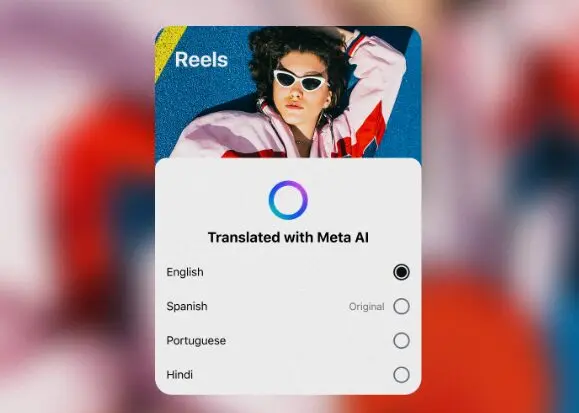- Meta AI translation for Reels now supports English, Spanish, Hindi, and Portuguese, with more languages planned for 2026.
- The system uses AI voice cloning and lip-syncing to make dubbed content feel authentic and creator-driven.
- The expansion opens major markets in India and Brazil, two of Meta’s largest and fastest-growing Reels regions.
- Translation is free and accessible to all public Instagram accounts and Facebook creators with at least 1,000 followers.
- Upcoming updates include auto-translated text stickers and multi-speaker translation, further enhancing global accessibility.
English, Spanish, Hindi, and Portuguese translations make cross-border discovery easier than ever on Facebook and Instagram.
Meta is taking another step toward making Reels a truly global format by expanding its AI-powered translation features to more languages. After debuting English and Spanish support earlier this year, Meta AI can now translate, dub, and lip-sync Reels in Hindi and Portuguese, allowing creators to connect with audiences across four of the world’s largest digital markets.
The update represents a major milestone in Meta’s ongoing effort to make social video borderless and accessible, transforming how creators grow and how audiences discover content on Facebook and Instagram.
“Many creators want to reach global audiences, and their feedback helped shape our work on translation features,” Meta said in a statement. “With multi-lingual translations between English, Spanish, Portuguese, and Hindi, creators can now share their content across some of the largest Reels markets on both Instagram and Facebook.”
In practical terms, this means Reels content can now be automatically localized into multiple languages without professional dubbing, ensuring that creators’ voices sound like themselves — just speaking another language.
Reels as Meta’s Global Discovery Engine
For Meta, this expansion is about more than just accessibility. Reels is now one of the company’s highest-growth products, driving user engagement across both Facebook and Instagram.
But its full potential has always been constrained by language.
With the addition of Hindi and Portuguese, the primary languages of India and Brazil, Meta’s two largest markets, the company is making a strategic play for global discovery. These countries not only represent vast user bases but also some of the world’s most active creator communities.
The ability to seamlessly translate Reels into a viewer’s native language removes friction from discovery. A Portuguese-speaking user can now engage with an Indian creator’s video as if it were originally recorded in Portuguese, while maintaining the creator’s tone, inflection, and personality.
That level of local authenticity at a global scale is central to Meta’s vision for the next phase of AI integration.
How Meta AI Translation Works
The technology behind Reels translation combines voice cloning, dubbing, and AI-driven lip-syncing to make cross-language content feel natural. When a creator enables translation, Meta AI analyzes their voice patterns — pitch, pace, and tone — then generates localized audio in the target language using the same vocal characteristics.
“Meta AI mimics the sound and tone of a creator’s voice to translate Reels, so the end result is content that feels authentically like the creator, just in another language,” the company explained.
Creators can also activate lip-sync alignment, which uses facial mapping to adjust mouth movements in the translated version. The goal is to make the dubbed content look realistic and emotionally consistent with the original, reducing the uncanny effect common in traditional dubbing.
The process is fully automated and optional. Creators can toggle “Translate voices with Meta AI” before publishing, review the output, and select which languages to release their translated Reels in. Once published, they can also view performance metrics by language, giving them insights into which audiences are engaging most.
Accessibility, Transparency, and Control
Meta’s translation rollout is not just about technology—it’s also about user trust and control. Every translated Reel is clearly labeled with “Translated with Meta AI” so viewers know when they are watching AI-generated content.
Viewers can choose whether to see translated versions or watch videos in their original language. A simple setting under the three-dot menu allows users to turn translations off or select “Don’t translate.”
Meta also gives creators full authority over their own content. Translations can be previewed, edited, or removed without affecting the original post. In terms of access, the feature is available to Facebook creators with at least 1,000 followers and to all public Instagram accounts in countries where Meta AI is supported.
This balance of automation and transparency reflects Meta’s broader AI policy—building tools that expand reach without compromising creator identity or user autonomy.
The Creator Opportunity — Global Reach, Zero Cost
The expansion of AI translations represents a structural shift in creator economics. Until now, breaking into new language markets required substantial investment—professional dubbing, translation services, or platform-specific teams. Meta’s system democratizes that capability.
Translation is free, fully integrated, and powered by Meta’s own AI infrastructure. For creators, that means access to international audiences without logistical or financial barriers.
Content creators like Roberto Nickson, who have been testing the feature, see it as a transformation in how creators scale globally:
“What was previously prohibitively expensive and reserved for only the top 1% of creators is now widely available for all,” Nickson said. “It’s the great equalizer.”
This equalizer effect could be especially meaningful for emerging creators in non-English markets, where growth is often capped by language visibility. With AI translation, creators can now publish once and reach globally, from São Paulo to New Delhi.
What’s Next: AI Text and Multi-Speaker Translations
Alongside the language expansion, Meta teased upcoming features that will make translated Reels even more dynamic. Soon, text and caption stickers will automatically translate into supported languages, ensuring that visual elements match the spoken translation.
Another forthcoming capability will allow AI to handle multi-speaker Reels, a complex step forward that will let group videos, interviews, or podcasts be localized seamlessly. These tools, combined with voice dubbing, will move Meta closer to a fully multilingual video environment, where cross-language storytelling feels natural and effortless.






